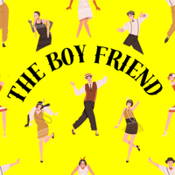
Overview
Synopsis
It’s Carnival time on the French Riviera, and the “perfect young ladies” of Madame Dubonnet’s Finishing School are all a=flutter with excitement at the opportunity to dress in beautiful frocks, dance the Charleston, and acquire that most prized of possessions -- a Boy Friend. Sweet young heiress Polly Browne, whose stern father forbids her to encourage men out of fear that they are after her money, is embarrassed to admit her lack of suitors to her friends, and must hide her shame by sending herself love notes. Enter Tony, a kind, romantic, handsome -- messenger boy! It is love at first sight for the darling duo, and Polly, pretending to be Madame Dubonnet’s secretary, enjoys for the first time a romance of equals. Confusion arises when Polly’s father, Percival Browne, arrives in Nice, only to discover in Madame Dubonnet a former flame, and rich old Lord and Lady Brockhurst appear in pursuit of Tony, leading everyone to assume he must be a thief. Will saucy French maid Hortense tell Polly’s secret? Will madcap Maisie choose between her four devoted swains -- or keep them all on a string? Will frisky Lord Brockhurst successfully evade his wife? Will Pierrette get her Pierrot? There’s a happy ending for everyone in The Boy Friend, Sandy Wilson’s popular spoof of 1920s’s theatrical, a light-hearted period romp celebrating lovers new and reunited, which features high-energy musical numbers, mistaken identities, plenty of ‘20s slang, and a flirtatious crowd of boys and girls.
Show Information
Context
Plot
Characters
| Name | Part Size | Gender | Vocal Part |
|---|---|---|---|
|
Lead |
Female |
Soprano |
|
|
Lead |
Male |
Tenor |
|
|
Lead |
Female |
Mezzo-Soprano |
|
|
Lead |
Male |
Baritone |
|
|
Supporting |
Female |
Alto |
|
|
Supporting |
Male |
Baritone |
|
|
Supporting |
Male |
Baritone, Bass |
|
|
Featured |
Female |
Spoken |
|
|
Featured |
Female |
Mezzo-Soprano |
|
|
Featured |
Female |
Alto |
|
|
Featured |
Female |
Alto |
|
|
Featured |
Female |
Soprano |
|
|
Featured |
Male |
Tenor, Baritone |
|
|
Featured |
Male |
Tenor, Baritone |
|
|
Featured |
Male |
Tenor, Baritone |
|
|
Ensemble |
Either Gender |
Soprano, Alto, Tenor, Baritone |
Songs
Act One
- Perfect Young Ladies - Hortense, Girls
- The Boy Friend - Ensemble
- *Won’t You Charleston - Bobby, Maisie
- Fancy Forgetting You - Madame Dubonnet, Percival
- I Could Be Happy With You - Tony, Polly,
- Act One Finale (The Boy Friend - Reprise) - Ensemble
Act Two
- Sur Le Plage - Ensemble
- A Room in Bloomsbury - Tony, Polly
- *It’s Nicer In Nice - Hortense, Ensemble
- The “You-Don’t-Want-To-Play-With-Me” Blues - Madame Dubonnet, Percival
- *Safety in Numbers - Maisie, Boys
- *The Riviera - Bobby, Maisie, Ensemble
- It’s Never Too Late To Fall in Love - Lord Brockhurst, Dulcie
- Poor Little Pierrette - Madame Dubonnet, Polly
- Finale - Ensemble
A song with an asterisk (*) before the title indicates a dance number; a character listed in a song with an asterisk (*) by the character's name indicates that the character exclusively serves as a dancer in this song, which is sung by other characters.
Monologues
Scenes
Key Terms
A lively 1920s dance, featured in period musicals to convey the cultural exuberance of the Jazz Age.
A period of artistic flourishing, often referring to 1940s-60s Broadway or English Renaissance theatre. This term plays a vital role in understanding theatrical structure and is commonly encountered in stagecraft or performance settings.
The “Golden Age Musical” refers to Broadway shows written roughly between the 1940s and 1960s, a period known for integrating songs, story, and character development. These musicals often balanced romance, comedy, and social themes with memorable melodies and large ensembles. Classics from this era continue to shape the foundation of modern musical theatre.
Parody is a comedic imitation of a style, genre, or work that exaggerates its features for humorous or satirical effect. In theatre, it playfully mocks conventions, characters, or cultural icons while still relying on audience recognition of the original. Parody can both celebrate and critique its subject, often blurring the line between homage and ridicule.
A humorous imitation of a genre or style, often used in theatre to satirize popular themes or famous works.
A production created to showcase the talents of a specific star performer, often tailored to their strengths.
Videos
Quizzes
Themes, Symbols & Motifs
Sorry! We do not currently have learning modules for this guide.
Quote Analysis
Sorry! We do not currently have learning modules for this guide.
